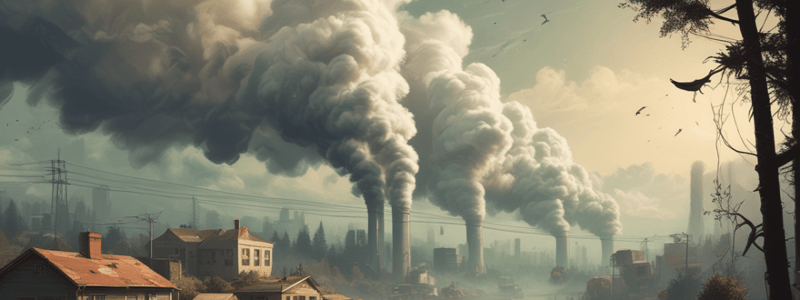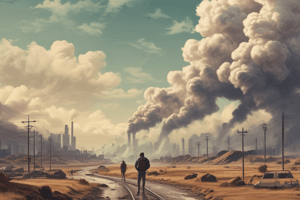Podcast
Questions and Answers
What is the effect of low-level exposure to nitrogen oxides in the air?
What is the effect of low-level exposure to nitrogen oxides in the air?
- It can cause burns, spasms, and dilation of tissues in the throat
- It can cause coughing and a feeling of shortness of breath (correct)
- It can lead to a longer life expectancy
- It has no effect on human health
What is the main source of nitrogen oxides in cities?
What is the main source of nitrogen oxides in cities?
- Agricultural activities
- Construction activities
- Industrial activities
- Traffic emissions (correct)
What is ozone?
What is ozone?
- A colorless gas with a strong odor
- A gas that is not naturally present in the atmosphere
- A pale blue gas with a strong odor (correct)
- A type of particulate matter
What happens when ozone is formed in large concentrations in cities?
What happens when ozone is formed in large concentrations in cities?
What is particulate matter composed of?
What is particulate matter composed of?
What is the effect of long-term exposure to particulate matter?
What is the effect of long-term exposure to particulate matter?
What is the main source of lead emissions in the atmosphere?
What is the main source of lead emissions in the atmosphere?
What is the characteristic of lead that makes it very dangerous for the environment?
What is the characteristic of lead that makes it very dangerous for the environment?
What happens to lead in the environment?
What happens to lead in the environment?
What is the main component of particulate matter?
What is the main component of particulate matter?
Flashcards are hidden until you start studying
Study Notes
Air Pollution
- Air pollution is the presence of materials or forms of energy in the atmosphere that can pose a risk, damage, or nuisance to living beings.
- Direct consequences of air pollution include the development of diseases and conditions in humans and biodiversity, as well as the loss of visibility or appearance of unpleasant odors in areas of large, concentrated populations.
Causes of Air Pollution
- Human action is the main culprit of air pollution.
- The burning of fossil fuels, such as coal or oil, is one of the main causes of air pollution.
Air Quality Categories
- The Air Quality Index (AQI) is a scale that ranges from 0 to more than 300, where 0 is a healthy air quality and more than 300 means that there are hazardous air quality conditions.
- There are six air quality categories, each labeled by a different color to help people identify the air quality value in any place:
- Green: 0-50, air quality is satisfactory
- Yellow: 51-100, air quality is acceptable, but may pose a risk for sensitive groups
- Orange: 101-150, members of sensitive groups may experience health effects
- Red: 151-200, some members of the general public may experience health effects
- Purple: 201-300, health alert: the risk of health effects is increased for everyone
- Maroon: 301 and higher, health warning of emergency conditions: everyone is more likely to be affected
Air Pollutants and Sources
- Air pollutants are substances or compounds that are introduced to the atmosphere by different sources, with certain concentrations that can have a measurable effect on humans, animals, vegetation, or building materials.
- Air pollutants can be classified by their effects as:
- Primary pollutants: the pollutant substances or compounds in the atmosphere that cause a direct effect or harm to environmental health
- Secondary pollutants: substances or compounds that are created from reactions between primary pollutants and components of the atmosphere
- Sources of air pollutants can be classified as:
- Human-made sources: derive from human activities and industry
- Natural sources: include natural activities, such as volcanic eruptions and natural forest fires
Types of Air Pollution
- The EPA has identified six of the most common types of air pollutants:
- Carbon monoxide
- Sulfur dioxide
- Nitrogen oxides
- Ozone
- Particulate matter
- Lead
Carbon Monoxide Pollution
- Carbon monoxide (CO) is a colorless and odorless gas that is formed by the incomplete combustion of organic material in the presence of oxygen deficiency.
- Main sources of CO include motor vehicles, industrial processes, forest and urban fires, and the incineration of organic matter.
Sulfur Dioxide Pollution
- Sulfur dioxide (SO2) is a colorless gas with a pungent odor.
- Main sources of SO2 include volcanic eruptions, the burning of fossil fuels by power plants and other industrial facilities, and the manufacturing of sulfuric acid, paper, food preservatives, fertilizers, etc.
Nitrogen Oxides Pollution
- Nitrogen oxides are hazardous types of air pollutants.
- Main sources of nitrogen oxides include traffic, combustion processes at high temperatures, and the action of atmospheric oxidants such as ozone.
Ozone Air Pollution
- Ozone (O3) is a pale blue gas that gives off a strong odor.
- Ozone is naturally present in the atmosphere at very low concentrations, but can form in large concentrations due to the chemical reaction between nitrogen oxides (NOx) and volatile organic compounds (VOCs) in the presence of sunlight.
Particulate Matter
- Particulate Matter (PM) is a complex mixture of suspended particles that pose a hazard.
- PM can be emitted directly into the air when they come from sources such as combustion processes or windblown dust, or they may be formed in the atmosphere by the transformation of gases emitted such as SO2.
Lead Pollution
- Lead (Pb) is another air pollutant.
- Main sources of lead emissions include gasoline-powered vehicles, chemical industries, mining industries, metal smelting and recovery processes, waste incineration, sewage sludge, coal combustion, and battery manufacturing.
Studying That Suits You
Use AI to generate personalized quizzes and flashcards to suit your learning preferences.




